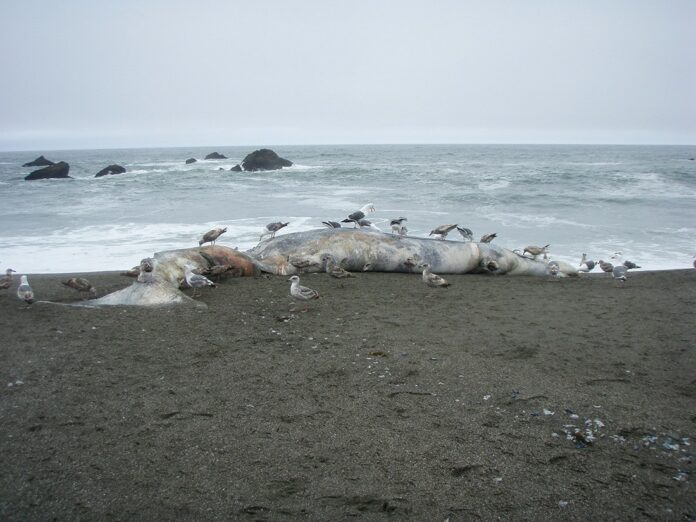Walking Sonoma and Marin county beaches recently has yielded some unusual sights and smells.
According to officials at the National Oceanic and Atmospheric Administration (NOAA), 12 dead whales have washed up on Northern California beaches in the last three months, including two along the Sonoma County coast and one in Marin County. The carcass of a young gray whale showed up on Portuguese Beach on May 23, with another gray whale washing ashore near Jenner around May 28. In Marin, a headless whale came ashore on South Beach along the Point Reyes National Seashore on May 26.
Other than the fact that they are all whales, what do the carcasses share in common?
“There is no unifying factor,” says Mary Jane Schramm, spokeswoman for the Gulf of the Farallones National Marine Sanctuary.
Marine scientists have identified four species among the dozen dead whales: orca, humpback, sperm and gray, which are commonly seen heading north along the coast this time of year. Their ages, along with their causes of death, have varied.
According to Schramm, one of the dead whales found in Pacifica was mature and possibly died of “old age,” given the condition and apparent wear on various body parts. Several others were young, possibly calves from the winter birthing season in Mexico, and may have been victims of predation by orcas.
One humpback was a victim of shipping traffic, while other whale carcasses have shown signs of possible “fishery interactions” such as net entanglements, which can mortally wound the immense animals.
In a typical year, one or two gray whale carcasses wash ashore. So what is different this year?
Since the 2013–14 winter, climatologists have noticed the formation of a “blob” of water in the northeastern Pacific Ocean that runs 3 to 4 degrees Fahrenheit warmer than usual. Nick Bond, a scientist with the Office of the Washington State Climatologist, says it currently extends from Baja to the Gulf of Alaska, and is up to 1,000 miles wide in places.
Both Bond and California state climatologist Michael Anderson agree that the warm-water mass is not directly related to climate change or the whale deaths since the phenomenon has been noted before. But Anderson believes that “climate change may be impacting the magnitude of the anomalies.”
Though climatologists believe the warmer water is a short-term condition that will likely last only a few years, it is nonetheless an unusual event which, according to Bond, we could consider “a dress rehearsal for climate change.”
Scientists agree that linkages between climate and organisms of all types are difficult to make. In order to conduct sound, meaningful research, commercial activities that could disrupt the ecosystem, such as the oil spill near Santa Barbara, need to be tightly managed or eliminated.
As it happens, the NOAA recently announced the expansion of marine sanctuaries along the Marin, Sonoma and Mendocino coasts. The Gulf of the Farallones and the Cordell Bank national marine sanctuaries are both increasing to more than twice the area they previously encompassed.
The expanded areas contain significant resources and habitats, including an “upwelling zone” originating off Point Arena. Upwelling is a process by which deep, nutrient-rich water rises to the surface. The upwelling zone along the Sonoma and Marin coasts is one of the most productive systems in North America, and contributes to the rich marine life in local waters.
The sanctuary designation protects these areas from oil and gas exploration, and makes it possible to regulate activities that could be detrimental to the ecosystem, such as commercial shipping speeds and fishing.
Frances Gulland, senior scientist with the Marine Mammal Center in Sausalito, believes that while the number of dead whales seen on North Coast beaches this spring may not be alarming, relative to the 1999–2000 catastrophe when 40 gray whales washed up on North Coast beaches, it is cause for concern.
“We just don’t know what is altering the distribution of these whale carcasses,” Gulland says.
The NOAA is hosting a celebration of the sanctuary expansion on June 28 from 11am to 3pm at the Gualala Arts Center.











